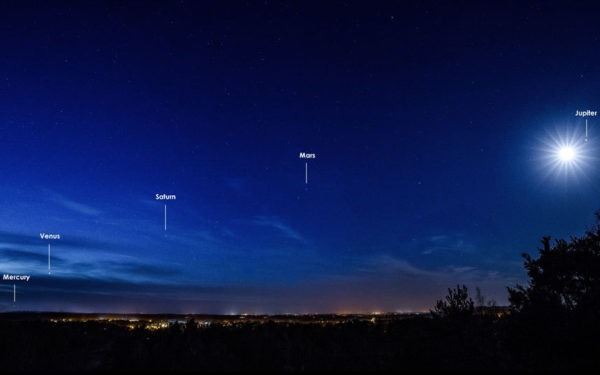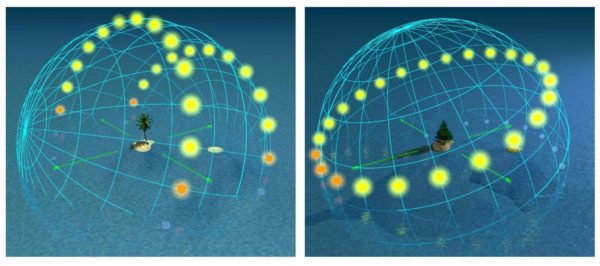"I long ago abandoned the notion of a life without storms, or a world without dry and killing seasons. Life is too complicated, too constantly changing, to be anything but what it is. And I am, by nature, too mercurial to be anything but deeply wary of the grave unnaturalness involved in any attempt to exert too much control over essentially uncontrollable forces." -Kay Redfield Jamison
Under ideal conditions, Mercury achieves a maximum elongation, or angular separation, from the Sun of 28 degrees. Total darkness is achieved when the Sun dips 18 degrees below the horizon. So for many of us, why is it that we’ve never been able to see the closest planet to the Sun, even when it appears we have ideal conditions?
 It only happens once every 11 years, but occasionally, all five naked-eye planets are visible at once. Mercury is always the toughest to spot. Image credit: Martin Dolan.
It only happens once every 11 years, but occasionally, all five naked-eye planets are visible at once. Mercury is always the toughest to spot. Image credit: Martin Dolan.
As you may have guessed, there’s more to the equation than that. A huge factor is your latitude, and what angle the Sun rises/sets at with respect to the horizon. If you live closer to one of the poles than the equator, there’s a good chance that you’ll never be able to see Mercury, even at this maximum, ideal elongation, as by time darkness sets in, the world is well below the horizon.


One problem with ourselves is that from earliest childhood even through to higher education... all the renderings we see of our solar system are HIGHLY inaccurate. And I do stress highly. And being in the graphics industry, I do understand fully well the problem about rendering such a system visually. And that you can match all scales and still have a usable and visually pleasing image. Something like metro maps. Very interesting design solution to a very similar problem. So we either show planets in scale, but not distance, or vice versa.. or sun in out proportion etc.. Later on we actually either find an image that's up to proportion on every length.. or we form our own picture based on numbers... but mentally we still all have an use that mental image where everything sort of fits. But in reality... all the planets are just dust grains in comparison to sun (except jupiter and saturn).. uranus and neptun somewhere in between... and distances between planets and sun in comparison to their diameter is enormous. IMO actually being able to see any planets with a naked eye is cool. And also the fact of how bright the stars shine.. being able to see things thousands of light years away with naked eye... wow.
@1: that's why I have some sticks with tiny planets on them, and every once in a while (maybe once per year) I break them out and my kid and I make a scale model of the solar system in the local green area. I use a 1 inch sun, which makes most of the inner planets just single pen dots, Jupiter 2.6 mm, and I take it out to Saturn (85 ft away).
I got my first proper view of Mercury in the Canary islands in December 2015 having had the high-latitude problem for my whole life before that. I had to check Google Sky to be sure of what it was, it looked bright enough and high enough in the sky to be Venus.
I'm pretty sure I saw it between two houses in the Western twilight once before but it wasn't very impressive!